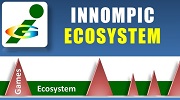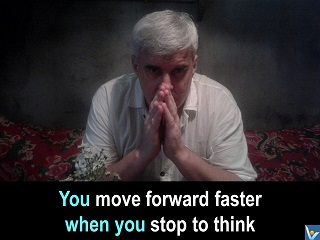|
| |
Holistic
Thinking Defined |
|
| |
Holistic thinking is
the ability to see things as a whole (or holistically),
to understand and predict the many different
types of relationships between the many elements in a complex system, and
also
perceive the
whole picture through sensing its large-scale patterns.
|
|
| |
3 Universal Laws |
3 K oRe Models |
|
| |
|
|
|
Holistic Thinking: Universal and KoRe Models
Universal laws of holistic thinking help to be and stay in harmony with
universal forces and energies.
KoRe models of holistic thinking are aimed at holistic and harmonious creation
of change and innovation.
These principles also apply to holistic
thinking in a business context:
| |
Vision as a Lodestar
Keep the big vision of the desired
future in mind as you create smaller parts to stay strategically
aligned and aware of the role each component plays in the entire
system and their interdependence. |
|
 |
All-inclusive love
Build Cross-functional Expertise
Synergise
Learning SWOT Questions
Holistic multi-rater Feedback, Positive attitude:
Example: Innompic Feedback Form
Stop to Think
Don't jump at solving a complex problem by
tackling seamingly obvious surface-level issues. resist the urge to tackle the
obvious surface-level issues—instead, dig deeper for the underlying patterns.
Know your overall objective. Holistic thinkers
constantly remind themselves of their primary objective, or what specific result
they are driving towards, which helps them to focus and not get distracted by
every tangential concern or issue. Rather, by thinking holistically, bumps in
the road are viewed more as learning opportunities and minor setbacks rather
than insurmountable challenges. This applies at the individual level as well.
When leaders I coach receive formal multi-rater feedback, they can sometimes get
distracted by a single comment or rating rather than staying focused on the
overall goal of development and core messages that will drive that development.
Correctly frame the problem/challenge. Michael
Watkins, a professor at IMD has stated: “Many managers are promoted to senior
levels on the strength of their ability to fix problems. When they become
enterprise leaders, however, they must focus less on solving problems and more
on defining which problems the organization should be tackling.” (emphasis
added, Harvard Business Review, June 2012). In the U.S. we have a strong bias
for action – we often hear that “doing something is better than nothing”, so we
see a problem and dive in to fix it. While this may sometimes be helpful, we can
also waste precious resources and cause huge headaches by trying to work on
something that was only a symptom of a larger underlying issue. Holistic
thinkers have the willingness and patience to step back and ask “what problem
are we trying to solve?” I recall working with a non-profit client who stated
that they wanted “more community support”. However, every person in the room had
a different idea of what “community support” meant. These differences then led
to a very useful conversation about “what is community support?” Only after they
clarified this issue could they then make progress.
Learn to recognize patterns. Just as similar color puzzle pieces are likely to
interconnect in specific ways, so are people, processes and systems likely to
affect one another in certain ways that can be predicted once patterns are
identified and understood. Rather than treating every issue that pops up as a
“one off” situation, holistic thinkers have the ability to see the
interdependencies, resulting patterns, and the implications of those patterns on
the overall objective. For example, if we want to improve employee retention,
holistic thinkers should seek for patterns not only in the circumstances of
those who have left the organization, but also patterns in those who have stayed
and flourished in the organization.
Unfortunately, most organizations have too many independent thinkers and far too
few holistic (or interdependent) thinkers. If you want to increase your capacity
to think holistically, resist the urge to tackle the obvious surface-level
issues—instead, dig deeper for the underlying patterns. This approach can help
ensure you’re working on the right problem and staying focused on your primary
goals.
   
| |
Systems and
Wholeness
"I shall proceed from the
simple to the complex. But in
war more than in any other subject we must begin
by looking at the nature of the whole; for here more than elsewhere the part and
the whole must always be thought of together."
~
Carl Von Clausewitz
→
Amazing
Thinker 360

The concept of "wholeness" is very important in
general
system analysis. The system must be viewed as a whole and modified
only through changes in its parts.
|
| |
Holistic Thinking
and
Systems Thinking
In
→
business
 and
→
organizations
and
→
organizations
 ,
holistic thinking is often used synonymously with systems thinking.
Systems thinking is your
ability to see things as a whole (or holistically) including the many different
types of relationships between the many elements in a complex system. ,
holistic thinking is often used synonymously with systems thinking.
Systems thinking is your
ability to see things as a whole (or holistically) including the many different
types of relationships between the many elements in a complex system.
→
Balanced Organization: 5 Basic Elements

→
6Ws of
Corporate Growth

Yet, 'holistic thinking' is a
wider concept that
involves
perceiving
a system through sensing its large-scale patterns.
Systems thinking is often
focussed on
→
problem solving
 through understanding elements of the system and their interconnections.
>>>
through understanding elements of the system and their interconnections.
>>>
→
Creative Problem Solving
This is, definitely, a valuable perspective to assist organisations
improve
performance. However, adopting other conceptions of holism may open up new
perspectives
which may also be very valuable.
→
Work
Smart and Hard
For instance, when
applied in social
situations, holistic thinking involves sensitivity,
intuition and tact.
Before modifications of the parts can be
made for the overall benefit of the system, a thorough knowledge of how each
part functions and the interrelationships among the parts must be present.
|
| |
Working Backward
The working backwards technique tells
us to consciously start from the end of the process and develop it
step by step from there. To
achieve success,
vividly imagine that you have already achieved your goal,
visualize
the whole picture, then walk back and examine the pathway toward
your goal...
More |
 |
| |
11 Traits
of a
True
→
IT Leader |
| |
❸ Foresight to connect disparate pieces into cohesive solutions...
More |
|